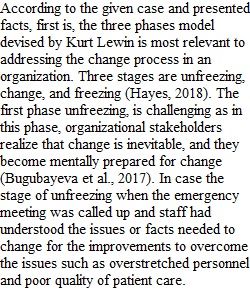


Q Final Exam - Case Study Briefing Note and Slide Presentation Final Exam – The final exam consists of a two-page briefing note, slide presentation, and video presentation. The briefing note, slide presentation, and video are worth 200 points. This is an expansion of the Case Study 34.1 Managing change in the Urology Department of a hospital in England. (Text page 515-516) 1. Reread the case. 2. Review your submission for the Unit 8 Case Study 3. Identify the three concepts or theories you feel are most relevant to this case. 4. Formulate the advice that you would give to the Urology Department manager. 5. Explain how this advice is informed by theory; i.e., relate your advice back to the workings of the theory (theories) you believe to be the most relevant to this case. Directions • Create a two-page briefing note that addresses o The three concepts or theories you feel are most relevant to this case. o The advice, recommendations, or conclusions that you would give to the Urology Department manager. Explain how this advice is informed by theory; i.e., relate your advice back to the workings of the theory (theories) you believe to be the most relevant to this case. • Create a PowerPoint or Prezi slide presentation that addresses the requirements stated above. • Create a video presentation Resource: How to Write a Briefing Note Written briefings are usually done in the form of briefing notes. A briefing note is a short paper that quickly and effectively informs a decision-maker about an issue. A well-prepared briefing note quickly and efficiently fills a person in on an issue. Some characteristics of a briefing note should be: • concise: a short document isn't necessarily concise; concise means every word is used as efficiently as possible • clear: keep it simple and to the point; always keep your reader firmly in mind and include only what matters to that reader • reliable: the information in a briefing note must be accurate, sound and dependable • structured: use headings, subheadings, lists, font, etc The most important point to remember about the structure of briefing notes is that they have three main parts: the purpose (usually stated as the issue, topic or purpose), a summary of the facts (what this section contains and the headings used will be determined by the purpose of the briefing note); and the conclusion (this may be a conclusion, a recommendation or other advice, or both) These three main parts could be presented under the following headings. Issue: (also Topic, Purpose): A concise statement of the issue, proposal or problem. This section should explain in one or two lines the topic, purpose or problem statement. Background: The details the reader needs in order to understand what follows (how a situation arose, previous decisions/problems, actions leading up to the current situation). Typically this section gives a brief summary of the history of the topic and other background information. What led up to this problem or issue? How has it evolved? Key Concepts/Theories: A summary of the key concepts or theories (3) you feel are most relevant to this case. Remember to substantiate any statements with evidence. Explain how this advice is informed by theory; i.e., relate your advice back to the workings of the theory (theories) you believe to be the most relevant to this case. Recommendations and/or Conclusions: Conclusions summarize what you want your reader to infer. Do not introduce anything new in the Conclusion. If you are including a recommendations section, it should offer the best and most sound advice you can offer. Make sure the recommendation is clear, direct and substantiated by the facts you have put forward. ________________________________________ Due Date • Submit by Sunday, 11:59 p.m., CT. Rubric Some Rubric (2) Some Rubric (2) Criteria Ratings Pts This criterion is linked to a Learning OutcomeContent 200 pts Full Marks 150 pts No Description 100 pts No Description 0 pts No Marks 200 pts Total Points: 200 Previous
View Related Questions